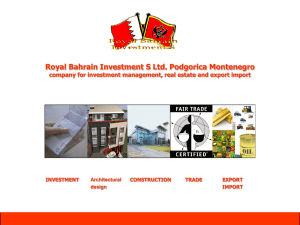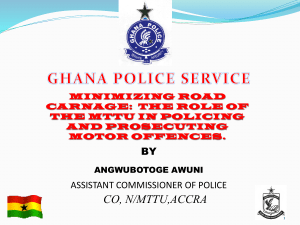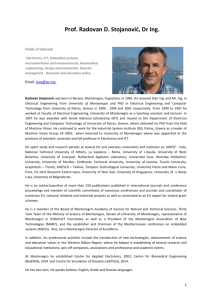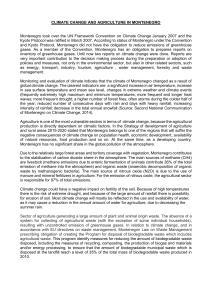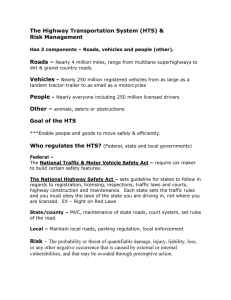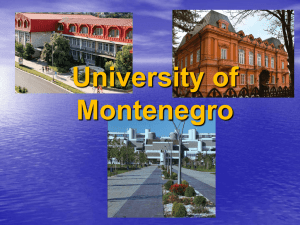S T R A T E G Y ROAD TRANSPORT SAFETY IMPROVEMENT
advertisement
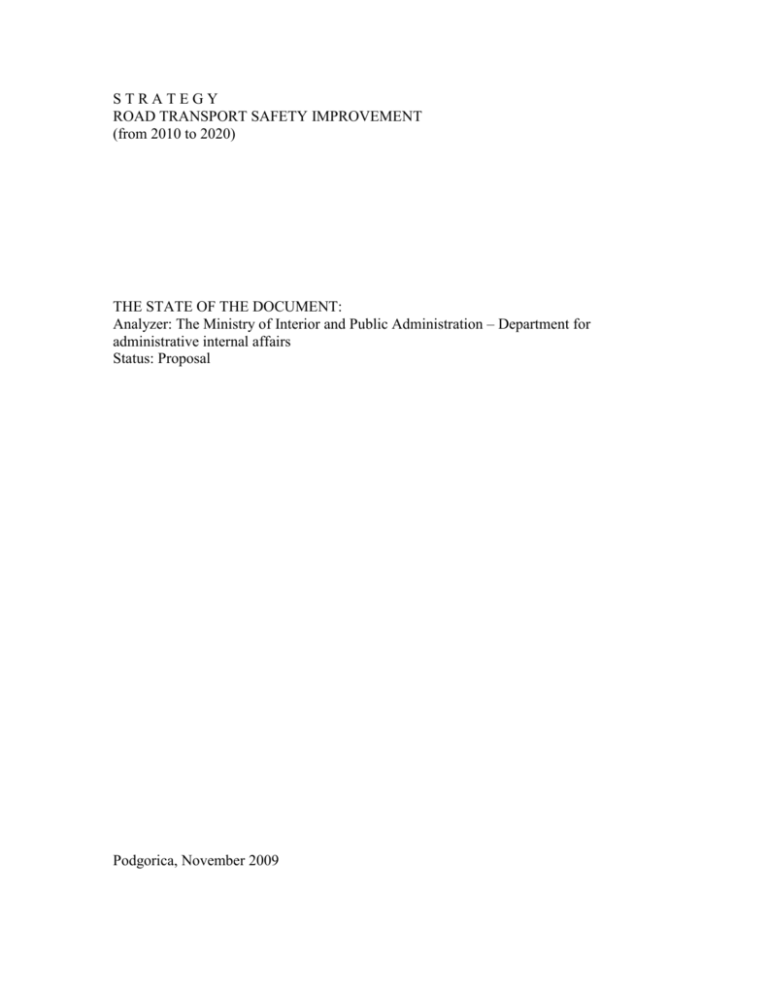
STRATEGY ROAD TRANSPORT SAFETY IMPROVEMENT (from 2010 to 2020) THE STATE OF THE DOCUMENT: Analyzer: The Ministry of Interior and Public Administration – Department for administrative internal affairs Status: Proposal Podgorica, November 2009 CONTENTS: 1. INTRODUCTION . 2. VISION 3. MISSION 4. OBJECTIVES 4.1. Short term objectives 4.2. Long term objectives 5. ORGANIZATION AND REGULATION OF ROAD TRANSPORT 5.1. Organization of road transport safety 5.2. Legal regulation 6. Education 6.1. Action priorities 6.1.1. Media campaign 6.1.2. Short term action priorities 7. PLANNING (roads, drivers and vehicles) 7.1. Road infrastructure 7.1.2. Action priorities 7.2. Drivers and vehicles 7.2.1. Drivers 7.2.2.. Vehicles . 7.2.3. Action priorities 8. Traffic accidents and theis consequences 8.1. Traffic accident causes . 9. Transport safety offences 10. Transport police 10.1. Equipping transport police 10.2. Prevention measures for speed reduction 10.3. Prevention measures for driving under the influence of alcohol . 10.4. Safety belts, helmets, child car seats 11. Establishing centralized database 12. Action priorities 13. Financial resources for strategy implementation 14. Responisibilities 15. Coordination body for supervising the implementation of the Strategy for improving the safety in road transport, monitoring and reporting 16. Summary 1. INTRODUCTION The Strategy of Road Transport Safety Improvement is a strategic document defining guidelines for road transport in Montenegro, containing necessary measures to be taken in order to achieve set objectives. Starting bases of the strategy should serve as a basis for the reform of road transport safety, and they could be changed and adapted for the sake of innovation and improvement of the safety system. The Strategy defines the development and functioning of the road transport safety system in Montenegro, and it represents the reflection of its commitment to constitute a segment of regional and global road transport safety systems. The Strategy defines state interests, security objectives, risks and challenges, possible reaction of Montenegro to these risks, as well as the structure of the road transport safety system on a national level. Road transport, as one segment of a comprehensive transport system represents a substantial factor of social happenings and contemporary society development, and it is certainly the most represented manner of both mass and individual means of transport, due to advantages it has over other means of transport. The transport itself is not a problem, but the problem arises from occurrences, relations and activities of human society. What highlights the problem of transport safety is the increase in the number of motor vehicles yet the relatively small increase of modern road network, as well as the fact that traffic accidents worldwide cause far more deaths than for other reasons. Basic indicators of the road transport safety in a certain area are traffic accidents and accident victims. According to the data provided by World Health Organization, traffic accidents claim approximately 1.5 million victims annually, with 15 million being hurt. Whether this growing trend of traffic accidents continues in the coming period, it is estimated that they would take a third position on a ‘list of ten leading causes of death’. Ten leading causes of death* 1990. disease or injury 1. respiratory infections 2. diarrheal diseases 3 prenatal conditions 4. unipolar depression 5. coronary heart diseases 6. cerebrovascular diseases 7. tuberculosis 8. morbilli 9. road traffic accidents 10. inborn anomalies 2020. disease or injury 1. coronary heart disease 2. unipolar depression 3 road traffic accidents 4. cerebrovascular diseases 5. chronic obstructive pulmonary diseases 6. respiratory infections 7. tuberculosis 8. wars 9. diarrheal diseases 10. HIV In the last ten years, the European Union has adopted a number of documents aiming at increasing the road transport safety level. Two basic documents containing elements related to road transport safety are: the White Paper* and the Road Safety Action Program. The White Paper is a document whose final version was adopted in 2001, in which the set objective is to reduce the number of traffic accident victims by 50% until 2010. Road Safety Action Program includes 60 measures which altogether represent the activities necessary for improving the road transport safety, within which there are three specific groups for transport safety: • • • road infrastructure beneficiaries; vehicles technology and road infrastructure. The European Union instruments used for meeting the objective are: legislatives, research and development, better implementation guidelines, financial support and data base. As a signatory of Stabilisation and Association Agreement between European Community and Montenegro, and with the adoption of Ratification Law, Montenegro confirmed state commitment to undertake all necessary activities and measures for its integration in European, Euro-Atlantic and other international structures. Road Transport Improvement Strategy is a document containing a vision, mission, objectives, key areas for road transport safety, the scope of work of bodies competent for * Road Safety is No Accident, A Brochure for World Health Day, 7.April 2004., WHO, 2004 (European transport policy for 2010 time to decide/COM (2001) 370 final, 12 September 2001) road transport security activities, and it represents the basis for its core reform as a dynamic and complex system which, besides systemic approach, includes active participation of all interested entities as well as corresponding publicity. 2. VISION Road transport safety is one of the fundamental elements of transport system quality. Each participant in transport as well as transport services’ user wants to have a transport system which meets its needs and expectations. It is the quality of life which depends on the safety level for all citizens. Montenegro shall provide road transport system which is safe, secure, efficient, reliable, ecologically friendly and integrated within European systems, and as such it shall meet users’ need and expectations for the quality of life. 3. MISSION Road transport system shall be developed in a way to: 4. provide safe, secure and efficient transport; raise social awareness; be ecologically friendly and minimize harmful effect on the environment; be harmonized with EU regulations and support the process of EU integration of Montenegro OBJECTIVES The Strategy objective is to reduce the number of traffic accident victims by 50% in 2020 in relation to 2007. 4.1. Short term objectives The Government of Montenegro shall establish a working body for monitoring the Strategy implementation, with a task to coordinate activities of competent bodies in this field. The Ministry of Interior and Public Administration shall be responsible for Strategy implementation, coordination, monitoring and analysis, based on the data provided by competent entities throughout the country. Taking into account other countries’ knowledge and experience, to introduce training system of officers in the field of road transport safety; Harmonize laws and practice with the European Union (the implementation of the transport safety audit within road planning – RSA (Road Safety Audits) and the inspection of road safety within the inspection of existing roads – RSI (Road Safety Inspection), accident investigation, traffic accidents database, the system of driving license issuing, fines, new drivers, campaigns, etc.) Reduce the number of victims by 30% until 2015 in relation to 2007; Reduce the number of victims by 20% until 2020 in relation to 2007; Reduce the number of grave injuries by 20% until 2020 in relation to 2007. 4.2. Long term objectives Harmonize the safety level of road infrastructure with the European Union, Establish the road transport safety system on all levels, Reduce the number of victims and injuries in case the length of roads and the number of vehicles in traffic increase, Reduce the number of victims by 50% until 2020, in relation to 2007, Reduce the number of grave injuries by 30% until 2020, in relation to 2007. 5. ORGANIZATION AND REGULATION OF ROAD TRANSPORT 5.1. Organization of road transport safety Organization of road transport safety is performed by state bodies which manage, plan, organize, harmonize and accomplish measures and activities within road transport safety. The work of state administration is performed by Ministries and other bodies in accordance with the Law on State Administration (Official Gazette of Montenegro 22/08) and with the Decree on Organization and Manner of Work of the State Administration Bodies (Official Gazette of Montenegro 59/09), as well as local self - government bodies, institutions and legal persons, as public authorities when these tasks are devolved, i.e. delegated to them. Besides other things, the Ministry of Interior and Public Administration performs administrative activities related to drivers and vehicles, analytical situation monitoring and strategic planning in transport safety, instructive action for implementation of strategies and policy related to this field, supervision over performance of police tasks and procedures, competence, legitimacy and efficiency of police tasks performance; provision and monitoring of implementation of law and other regulations. From the aspect of road infrastructure, the Ministry of Transport, Maritime Affairs and Telecommunications performs activities related to road transport safety and security; proposing measures of existing and developmental policy and analyzing their impact on economic position of economic operators in the field of transport; as well as administrative supervision within its competencies. The Ministry of Health performs activities related to health care system achievement, organization and action, and performs supervision within its competencies. The Ministry of Education and Science performs activities related to planning, establishment and development of education system, and performs supervision within its competencies. Besides other things, the Ministry of Spatial Planning and Environmental Protection performs activities related to: construction of investment building; approving the construction and usage of state roads and road objects; coordination of relationship with certain countries concerning the issues of monitoring and improving economic cooperation; performing the activities for which it has been established. National police performs activities related to: citizen security protection and prevention from committing crimes and offences and their reveal; discovering and capturing criminal offenders; supervision and control on transport safety; carrying out analysis, reports, studies and monitoring certain safety issues. Transport Directorate performs activities related to managing, development, construction, reconstruction, maintenance and protection of state roads. State Road Inspection performs the audit of road correctness, which falls under the competence of the Ministry of Transport. Transport Directorate performs the technical audit of roads, through the service for supervision of construction and reconstruction of roads. Maintenance falls under the competence of Transport Directorate which concludes four-year agreements with businesses specialized for road construction and maintenance and it disposes of the technology and staff trained for this purpose. The Law on Road Transport Safety (Official Gazette of Montenegro 72/05 and 27/06) defines the field of transport safety on the roads, special safety measures related to investigation and control of drivers, going for a driving exam and issuing driving licenses, whereas the Law on Roads (Official Gazette of Montenegro 42/04) defines the road transport itself. Local self-government unit manages transport in its area, defines the right-of ways; oneway and two-way streets; setting the horizontal, vertical and light signaling; speed restriction; space for pedestrian paths, bicycles, motor bikes, horse-drawn vehicles and space for cattle drive; parking space; pedestrian zones, safety direction for participants and special technical measures for pedestrian safety near educational, health and other institutions, playgrounds and likewise (Article 2 of the Law on Road Transport Safety). 5.2. Legal regulation Road transport safety has been defined by: the Law on Road Transport Safety (Official Gazette of Montenegro 72/05 and 27/06); the Law on Roads (Official Gazette of Montenegro 42/04); the Law on Transportation in Road Transport (Official Gazette of Montenegro 45/05); the Law on Transportation of Dangerous Substances (Official Gazette of Montenegro 05/08); Law on Adult Education (Official Gazette of Montenegro 64/02 and 49/07); Law on Basic Education (Official Gazette of Montenegro 64/02 and 49/07) and the decisions of local self- government units. Offences related to road transport safety have been defined by the Law on Road Transport Safety, for which there are sanctions to be imposed. A fine may be imposed for offences defined within this law, whereas, besides a fine, a protection measure of driving prohibition may be imposed for more serious offences. Criminal offences committed against public transport safety have been defined within Criminal Code (Official Gazette of Montenegro 70/03 and 47/06), for which the sanctions imposed are: imprisonment and fine or imprisonment. 6. Education Education system is a significant segment of road transport safety. Insufficient education and ignorance about regulations on road transport participants are the most common cause of traffic accidents. Special attention must be paid to the improvement of education of the participants in transport as well as to the development of transport culture, which represents the basis for increasing the level of road transport safety and achieving European standards. Developed countries’ experience shows that special attention should be paid to school children, the young, drivers and other participant in transport. Formal education, realized by both preschool and school institutions, is provided through regular curriculum for gaining knowledge and increasing transport culture, whereas informal adult education is performed in driving schools, through the process of preparing candidates for passing driving exams. 6.1. Action priorities In order to provide adequate behaviour of all transport participants, it is necessary to enhance programs and the existing system, through preschool education, elementary school, secondary school and adult education centers in relation to: - first steps in transport basic knowledge on traffic signs, the right to right-of-way, etc. basic life lessons (basics to road transport safety) rules of behaviour in transport while on a way to school, home or work rules of behaviour for cyclists in transport (for elderly participants) preparation for passing driving exam. The existing curricula are in need of reform and innovation in order to be more efficient. 6.1.1. Media campaign Media campaign for raising citizens’ awareness: - Implement corresponding media campaign aimed at making the transport culture of all participants popular. In an educative manner, by using TV spots, place the - contents indicating to drastic examples of transport rules violation and consequences following from such behaviour of participants. It is necessary to publish periodical and annual statistic comparative results on the number of traffic accidents and the number of victims in Montenegro, as well as on a regional and EU level. 6.1.2. Short term action priorities Short term action priorities which need to be undertaken are: - - - prepare regulations on special conditions, manner of establishment and organization of the work of institutions performing educational work, manner of keeping records on candidates’ training adopt curriculum; implement reform of procedures and teaching materials in accordance with laws, and harmonize these with the European Union standards; educate teachers of theoretical and practical teaching, members of examination commissions, and all transport participants; introduce amendments of the Law on Road Transport Safety and make legal provision that the drivers who have passed driving exam may, for some period of time, drive motor vehicles exclusively in the company of some other experienced driver; impose special sanctions for young drivers. 7. PLANNING (roads, drivers and vehicles) 7.1. Road infrastructure The length of road network in Montenegro is around 6,900 km, whereof 940km are main roads, 964km regional roads and around 5,000km local roads. Having regard to physical characteristics, most of the main and regional roads are in adverse conditions, and they are conditioned by both terrain configuration and manner of construction. Namely, more than 66% of main and regional roads are built more than 25 years ago, which is the reason why it is necessary to invest in road network maintenance and protection. Becoming aware of the priorities of road network maintenance makes considerable increase in investments concerning maintenance, therefore, the amount of funds in 2003 was € 2.5 million, whereas in 2009 it was increased to € 10 million. From 2006 to 2009, more than €270 million has been allocated for construction, modernization and maintenance of state roads. Safe and secure transport includes high quality infrastructure without hazardous spots causing traffic accidents. With a view to raise the level of safety and security, as well as to enhance the quality of road network, 47 critical spots have been removed – the spots identified as the ones where the most traffic accidents occurred. Also, in cooperation with municipalities a Program of removing bottlenecks on state roads has been composed, implying construction of bypasses around bigger towns in Montenegro and construction of third lines at bottlenecks on Adriatic Main Road (Jadranska magistrala), with a view to reduce traffic jam and congestions in towns. The implementation of the program is going on mainly in accordance with a dynamic plan within which third lines have been constructed, 40 km in length. The construction of bypasses around Bijelo Polje, Nikšić, Kolašin and Golubovci is ongoing, whereas technical documentation for bypasses around Tivat, Kotor and Budva is being prepared. Also, the Government has adopted a Program of roundabout reconstructions on state roads with a view to enhance road infrastructure, further continuous solving of the bottleneck issues on main and regional roads, and due to the increased frequency of vehicles on Montenegrin roads, traffic flow increase, safety and security level. Namely, in the previous period, more than 80 projects have been implemented on a Montenegro road network, with a view to increase the level of safety and security as well as to raise the level of services for the users. It is important to notice that the quality of road network in Montenegro, as well as transport safety and security standards will be enhanced with the construction of two highways Bar- Boljare and Jadransko – Jonski highway, in accordance with Transport Strategy of Montenegro and Physical Plan of Montenegro by 2020. It is also important to emphasize that, in the field of road transport, and with a view to achieve high level of environmental protection, adoption of a new decision has been planned, by which technical safety requirements and environmental protection conditions will be considered met, if the vehicle possesses the minimal standard EURO 4 motor. The adoption of this secondary legislation has been planned for 2010. A Decision on conditions which have to be met by used motor vehicles imported on the basis of EURO 3 standard is currently being applied. Furthermore, upon drafting technical documentation for roads’ construction and reconstruction, an obligation of estimation of the harm inflicted upon the environment has been introduced, in accordance with the Law on Estimation of the Harm Inflicted upon the Environment (Official Gazette of Montenegro 80/05) and the Decree on Projects for which the harm inflicted upon the environment is estimated (Official Gazette of Montengro 20/07). 7.1.2. Action priorities Measures that should be taken to improve road infrastructure are: • To execute road screening depending on the risk, within the EURORAP system • In accordance with EURORAP program to take measures to cure the hazardous spots (critical points); • In order to ensure acceptable progress on reducing serious accidents, it is necessary to analyze and improve the existing road network, for what is required to follow several transport safety instruments: - Assessment of impact on traffic safety - Revision of Transport Safety, - Transport safety, transport safety ranking and management of the road network in the work including the inspection of transport safety, These instruments of the transport safety will help to integrate safety on the roads, as well as to consider operations of transport infrastructure and transport safety from the road aspect in all phases of planning, designing of road infrastructure. In addition, it is necessary to add sufficient legal regulations in the existing Law on Roads, pursuant to Directive 2008/98/EZ to prescribe mandatory application of road safety audits during the process of designing roads (Road Safety Audit) as well as an Inspection of transport safety at inspection of existing roads (Road Safety Inspection). According to the Directive 2004/54/EC, within changes in the Law on Roads, it is necessary to impose safety requirements for tunnels, i.e. to transfer requirements from the directive (2004/54/EZ) into the national legislation. 7.2. Drivers and vehicles 7.2.1. Drivers According to the records kept by the Ministry of Interior and Public Administration, there are 213,638 drivers in Montenegro, i.e. driving licenses which are issued and valid. This data refers to 30 November 2009. 70, 837 out of these 213,638 are the drivers aged 18 to 30. 7.2.2. Vehicles In the latest 10 years, the number of registered vehicles and side-cars in Montenegro is constantly increasing. According to the data provided in 2008, the total number of registered vehicles was 212,133 (produced until 1999 – 159,139; until 2004 – 25, 129 and until 2004 – 27, 865). The number of registered motor vehicles and side-cars Year: Number of vehicles: 1998 178,736 1999 128,450 2000 129,965 2001 2002 2003 2004 2005 2006 2007 2008 112,298 116,725 119,915 123,181 143,667 186,776 199,457 212,133 The forms of registration card and driving licenses are done in accordance with ISO/IEC 18013-1 standards, as identification cards, containing protection elements, guarantying document security. A proof on registered vehicles are registration card and a label on conducted technical check which is places from the inside, in right corner of windshield, containing: a month and a year of expiry of a regular technical check and data on registration plate. The Law on Road Transport Safety defines the obligation, conditions, manner and procedure for registration of motor vehicles, side-cars and motor-drive vehicles, as well as license prolongation. The Law on Road Transport Safety defines technical check of motor vehicles, side-cars and motor-drive vehicles and vehicle inspection. The check of technical correctness of vehicles is conducted at technical check (regular, preventive and special), companies or entrepreneurs, who are obliged to provide unique information system and perform data processing on technical checks and to submit these to a competent body. These records on technical checks are not kept in electronic form. The state of technical correctness of motor vehicles participating in transport significantly influences the road transport safety. 7.2.3. Action priorities It is necessary that the body competent for health affairs defines conditions in respect of the staff, equipment and date of expiry of medical certificate; Provide implementation of the Law on National Vocational Qualification (Official Gazette of Montenegro 80/08 and 14/09); Innovate the program of driver training of candidates Estimate whether it is necessary to increase the number of training classes and Harmonize the work of technical check stations with legal regulations. 8. Traffic accidents and their consequences According to the Law on Safety of transportation on roads, accidents is an event on a road in which at least one vehicle in motion is involved and one or more persons are injured or killed, or died within 30 days from the consequences of traffic accidents or material damage is caused. Based on comparative data analysis on traffic accidents, their causes, consequences, and other characteristics, and reports of the Police Administration in 2007 compared to 2008, a decline in the number of transportation accident is recorded. In order to continue downward trend in the number of traffic accident it is necessary to take further measures and actions to improve safety in road transportation. Statistics on traffic accidents and their consequences for period of 10 years are shown in Table 1 Table 1: Traffic accidents 1999 - 2008 Traffic accidents 1999 2000 2001 2002 2003 2004 2005 2006 2007 2008 Total Total With material damage With victims 6,549 5,042 5,597 4,316 5,275 3,962 5,503 4,285 5,094 3,926 5,377 4,157 6,192 4,845 7,185 5,631 8,882 7,008 10,170 8,410 65,824 51,582 1,507 1,281 1,313 1,218 1,168 1,220 1,347 1,554 1,874 1,760 14,242 Traffic accidents 1999 2000 2001 2002 2003 2004 2005 2006 2007 2008 Total Victims in total Driver victims Passenger victims Bicycle or motor bike victims Pedestrian victims Injured persons Total Less injured 146 59 53 5 81 23 36 5 105 28 47 4 81 29 24 3 84 39 28 5 91 40 30 6 95 44 30 6 85 31 27 9 122 59 33 5 112 47 42 6 1002 399 350 54 29 2,303 17 1,933 26 1,957 25 1,834 12 1,702 15 1,750 15 1,942 18 2,257 25 2,796 17 2,473 199 20,947 1,585 1,356 1,353 1,280 1,266 1,282 1,459 1,748 2,213 1,956 15,498 718 577 604 554 436 468 483 509 583 517 5,449 Seriously injured Traffic accidents 1999 2000 2001 2002 2003 2004 2005 2006 2007 2008 Ukupno Accidents scene investigations in total Self-executed accident scene investigations Accident scene investigations with 6,520 5,593 5,272 5,503 5,094 5,377 6,191 7,156 8,882 9,861 65,449 6,046 5,200 4,912 5,196 4,857 5,110 5,911 6,888 8,586 9,597 62,303 474 393 360 307 237 267 280 268 296 264 3,146 an investigations judge According to the table above, the number of traffic accidents on annual basis is increasing (in 2004 – 5,377, and in 2008 - 10,170), as well as the number of victims and injured person (the most in 1999 - 146 victims and 2,303 seriously and less injured persons and in 2007 - 122 victims and 2,796 seriously and less injured). Due to worsening situation in the safety of road transportation in 2007, Police Administration adopted the Plan for strengthened preventive and repressive activities and measures from the side of traffic police officers on the roads in Montenegro and the Plan had come and been in force from February 2008 until the end of 2009, supported by campaign and it provided positive results, so the number of victims and injured people decreased in 2008. These data are presented in Table 2 Comparative data on traffic accident for 2008 and 2007 Traffic accidents 2008 2007 Index % 10.170 8.882 14,5 With material damage 8.410 7.008 20,0 With people harmed 1.760 1.874 6,1 49 63 22,2 45 46 2,2 1.666 1.765 -5,6 Victims - total 112 122 - 8,2 Driver victims 47 59 Passenger victims 42 33 Bicycle victims 3 0 0 Motor-bike victims 3 5 40,0 Pedestrian victims 17 25 - 32,0 Injured people - total 2.473 2.796 - 11,6 Less injured 1.956 2.213 - 11,6 517 583 - 11,3 Total With victims With both victims and injured With injured Seriously injured 8.1. Traffic accident causes - 20,3 27,3 Based on analytical monitoring and examination of traffic accidents and their consequences, main causes of traffic accidents are: 1. low level of citizens’ awareness on dangers threatening to them during participation in road transport; 2. low level of transport culture with participants in transport; 3. infringement or ignorance of regulations related to road transport safety; 4. insufficient training of both candidates and drivers. Mentioned causes are mostly manifested through: 1. weak concentration of participants (drivers and pedestrians) on conditions in which transport takes place, and on terrain configuration through which the road they are taking is constructed; 2. Infringement of the right to right-of-ways of other participants in transport; 3. exceeding the speed limit 4. not adjusting the speed to road characteristics and state on the road and other conditions; 5. illegal passing and bypassing of a vehicle 6. driving under the influence of alcohol, drugs and other narcotics; 7. driving unregistered and technically incorrect vehicle; 8. driving prior to gaining right to driving, etc. The overview of registered offences according to their frequency is shown in table 3. The overview of registered offences according to their frequency Offences Illegal passing A driver without a driving license with him/her 2008 20,335 9,958 2007 17,528 0 Ratio % 16 0 Driving unregistered vehicle Exceeding speed limit for more than 30km/h in a settlement and for more than 50km/h on a road which is not in a settlement Passing with a vehicle when it is prohibited by light signalization 7,929 7,163 6,679 5,913 18.7 21.1 6,590 3,437 91.7 Driving prior to issuing driving license 6,107 5,417 12.7 A driver without a registration card with him/her 5,213 0 0 Driving under the influence of alcohol, and refusing to undergo alcotest 4,637 1,435 223.1 Technical incorrectness of main devices on a vehicle and exceeding dimensions, overall mass and axle weight 2,314 2,163 7.0 Illegal changing lanes Driving while driving license is temporarily taken or a driver is exempted from traffic, or driving while under protection measure of driving or driving an exempted vehicle 1,480 1,385 0 0 7,83 76.9 Table 3 9. Transport safety offences The number of registered transport safety offences on the roads has been increasing year by year. The most frequent offences have been the following: disrespect of traffic lights; driving under the influence of alcohol or narcotics; driving without having passed driving exam or prior to issuing driving license; driving during protection measure of banned drive or exemption from traffic; exceeding the allowed speed limit; driving nonregistered vehicle, which needs reliable records in electronic form. Number of registered transport safety offences years: Number of offences: 2002 21,733 2003 38,864 2004 41,887 2005 31,269 2006 66,734 2007 138,215 2008 111,848 Law on offences defines that an offence procedure for offences for which an imprisonment is prescribed or imprisonment together with a fine or just an imprisonment or a fine, as well as the procedure towards underage persons shall be managed by district bodies for offences. Ministries, public administration bodies and local government bodies shall manage an offence procedure for offences for which a fine is prescribed. The manner of organization of performing affairs in this field, in terms of competences and authorizations provided by the reform of offences are and by adopting new Law on offences shall provide more efficient conduction of an offence procedure. 10. Transport police In National Police, transport police affairs are conducted by 748 officers. Conducting offence procedures is done by 21 authorized officers for conducting offence procedures. 10.1. Equipping transport police According to the estimation of National Police, transport police do not dispose of necessary means and working equipment. Existing means and operation technics (vehicles, hand radars, radars, video cameras, alcometers, etc) are insufficient for successful problem solving in this respect. It is necessary to provide funds for implementation of the project concerning technical equipping of transport police with modern technical means and equipment, principally by installing a number of stationary systems for speed control and passing through red light, as well as supply with a number of systems for control of the moving traffic, in order to have more efficient control and regulation over road transport safety. Namely, by application of new law on systematization and organization of National Police, the number of officers will, besides the huge problems in this area, be reduced by more than 30%, so that is one of the reasons confirming the necessity of supply with modern technical equipment, which would lead to more efficient work and improvement of road transport safety. It is necessary to organize and implement additional and specialist training of transport police officers and others, with a view to gaining additional knowledge and more efficient performance. 10.2. Prevention measures for speed reduction According to the transport police, fast driving is the main cause of lethal accidents in the road transport caused by drivers of motor vehicles. However, there is no doubt that the choice of an appropriate speed which is in accordance with traffic conditions and obeying speed limit help in reduction of the severity and the number of accidents. The police should prepare programs of the transport police operations, in accordance with the Strategy for improving the safety in road transportation. Activities of the police with respect to the speed should be a part of a global campaign and should support the campaign. Specific measures that need to be introduced or further strengthened by the police are: - Set up fixed security cameras, especially in urban areas and at interchanges and crossing points of high-risk roads (execute gradually until 2013 year); - Setting up cameras in accordance with the principle of " road section control" would be desirable for usage on high-risk road sections and to place them along the primary network (gradually until 2015). This also applies to the measurement of an average distance; - Setting up mobile cameras for measuring the speed will additionally be used with an option to charge penalty at the spot - Specified responsibility of the owner of a vehicle in case of violation of traffic rules - Police should follow a policy of a "zero tolerance” through their work, etc.. 10.3. Prevention measures for reducing driving under the influence of alcohol The problem arises from traffic accidents caused by drivers who are under the influence of alcohol or narcotics. It is necessary to work more on implementation of regulations related to driving under the influence of alcohol. After each severe accident it is necessary to conduct investigation related to the impact of driving under the influence of alcohol or narcotics on the very accident. Police work on combating ‘drinking and driving’ should also be a part of global campaign against driving under the influence of alcohol. The police should constantly control traffic. The police shall be given a right to take away a driving license on the spot. The Law on Transport should be changed in a part related to the approved level of alcohol in blood. The upper limit should 0.2 instead 0.5 g/kg for all drivers, while for new drivers in the first three years after gaining driving license it should be 0,0 g/kg. 10.4. Safety belts, helmets, child car seats Safety belts are a very efficient way to reduce the number of victims and injuries with permanent consequences for passengers in vehicles. Child car seat is an efficient way of reducing severe and fatal injuries of children. They primarily function to hold children in a case of crash. In order to avoid severe head injuries in case of accidents, all motorcyclists, including drivers of smaller motorbikes, and their co drivers should wear helmets. In order to achieve higher level of application of the abovementioned measures, it is necessary that the police undertake the following: - intensive traffic controls, and corresponding penalties in the case of non-wearing safety belts. Safety belts should be used on all seats in cars, vans, including smaller tracks and other vehicle categories; - intensive controls related to the use of helmets by drivers and passengers on motorbikes and - regulation requiring the use of child car seats. This measure should be a part of a global campaign, and shall be implemented immediately after adoption of the Strategy. 11. Establishing a centralized database Law on road safety prescribes an obligation of managing and collecting the record of penalties imposed, the protective measure, penalty points, safety measures, traffic accidents and their consequences. Police Administration is the one that is competent for managing the database, as they are in charge of the relevant agency for information technology, which has been established for the purpose of supporting the operations of the Police Administration. Also, the Law on road safety prescribes an obligation of managing the record on drivers and vehicles. This record is managed by the Ministry of Interior and Public Administration and the same record has been set up in an electronic form as an electronic register about drivers and electronic register of registered vehicles. Users of these data are relevant bodies for performing tasks within their competence, judicial authorities, bodies authorized to conduct infringement proceedings and other relevant authorities. Electronic database of penalties imposed, protective measures, penalty points, safety measures and traffic accidents and their consequences, which is required to be established by the Police Administration must be in accordance with the European database on road accidents CARE (Council Decision 93/704/EC). 12. Action priorities • Prepare amendments to the Law on Road Transport Safety, after adoption of new laws on courts and offences, for the sake of harmonization; • Perform amendments of the Law on Road Transport Safety, fines referred to in articles 302, 303, 304, 305 and 306, shall be defined in fixed amount, pursuant to regulations; • Plan and implement a program of training officers from police and the ministries. • Data on imposed sanctions, protection measures, penalty points, security measures, traffic accidents and their consequences should be inserted in centralized database, which should be available to authorized users; • Conduct officers’ training for using the database. 13. Financial resources for strategy implementation The management that is responsible for implementation of the this strategy will plan and provide resources from the Budget of Montenegro, as well as other resources. 14. Responsibilities Each entity in the scope of its own work is responsible for implementation of the Strategy for improving the safety in road traffic for the period 2010 – 2020, which will enable achievement of goals that were set up. 15. Coordination body for supervising the implementation of the Strategy for improving the safety in road transport, monitoring and reporting The Government of Montenegro will form a coordination body for the safety in road traffic in order to coordinate the work of all relevant entities, i.e. authorities competent for a road transportation safety, implementation of the traffic safety policy in Montenegro and monitoring of implementation of the Strategy for improving safety in road traffic for the period 2010 – 2020, monitoring and reporting. This coordination body is formed to create the institutional framework for coordination of all subjects and competent authorities in the field of traffic safety and for implementation of traffic safety policy in Montenegro. By consistent implementation of the Strategy, Montenegro will establish a stable system in the safety of the road transportation. This body will continuously follow the traffic safety situation on the basis of reports submitted from all relevant entities, inform the professional, political and general public about the transportation safety, determine and review the goals of the traffic safety, suggest creation and implementation of the optimal measure for the purpose of a permanent reduction in the number of accidents and particularly the number killed and injured persons, and achieving the desired goals. 16. Summary The increased number of traffic accidents with death consequences is one of the main causes of violent death. In addition, with expected increase in the number of vehicles, the risk from road traffic accidents will increase. Functional transport system (basic network) must provide high quality, without counting the number of traffic accident victims on a daily basis. The Strategy on the Road Transport Safety is main and systematic means for reducing the total number of victims. All suggested mechanisms should be used and monitored. The implementation of the Strategy on Road Transport Safety is one of the steps towards safe road transport.

